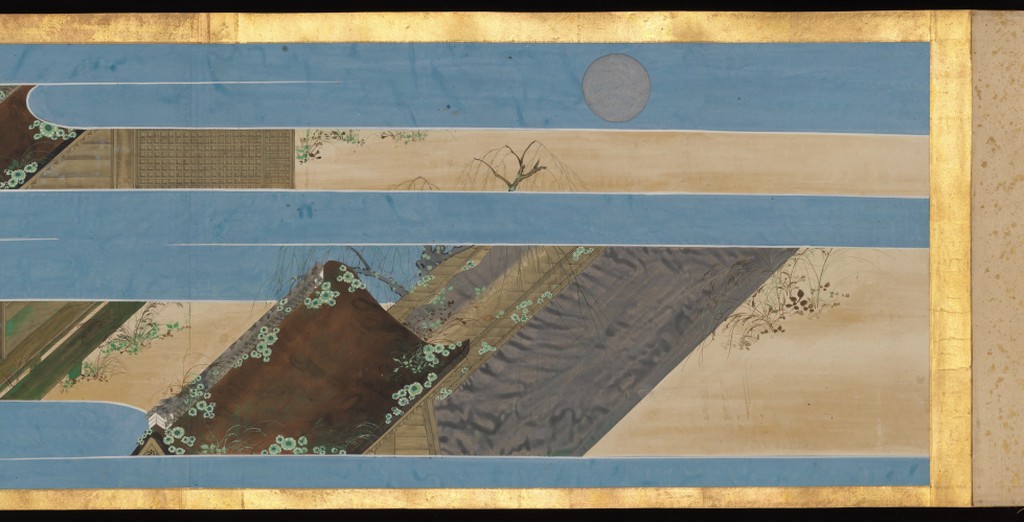

Title: Tale of Strange Marriage (Konkai Zoshi)
Artist: Ukita Ikkei
Date: ca. 1858
Location: Metropolitan Museum of Art
Culture: Japanese, Edo Period (1615 – 1868)
Medium: Handscroll; ink and color on paper
Dimensions: 11 ¾ in. x 25ft. 6 in.
Repository: Metropolitan Museum of Art
Description: This print show rich blues of the water and fiery red of the rising sun, all framed by a delicate gold leaf around the perimeter. The complex composition of the painting gives the viewer multiple perspectives on how to experience the scene.
This image is of the first scene of the scroll which, we get a wonderful image of a lone fox under a silver moon, on a coastline which seems to linearly flow into the next scene. On the top left corner, we see a dainty fox hidden among the bushes raising its’ right paw up to welcome the silver moon. We can see the clear expression on the fox’s face, smirking with eyes focused on the moon up above, possibly anticipating its transformation to human. Bisecting the scene is the roof of a house, with splendid green moss and flowers growing across it. The night breeze is shown through intersecting light blue lines that flow in and out of the main scene, a creating a flowing directionality of the story. These thoughtful details of nature’s interaction with humanity enforce the harmonious relationship between the two. The viewer is taken through a visual journey of movement, color, and perspective to create a unique experience.
The painting, Tale of Strange Marriage by artist Ukita Ikke, is a dynamic and politically charged Japanese painting. This historical story-telling technique is used throughout Japanese artwork, depicting scenes in which mischievous foxes play the role of humans. Particularly, this painting is playing with the myth in which foxes transform themselves into humans in the moonlight. Ukita Ikke is using this painting as a mode to critique the actions of the Tokugawa shogunate, who tried to gain power by marrying the imperial princess to the shogun. Shortly after the creation of this painting, Ukita Ikke was imprisoned during a mass arrest of anti-Tokugawa supporters.
Photo Reference: Photo taken from Metropolitan Museum of Art
References: Tajima Shiiji 田島志一, ed. Shinbi taikan 真美大觀 (Selected relics of Japanese art) Kyoto: Nippon Bukkyō Shinbi Kyōkai, 1902, vol. 8, n.p., pl. 38 (two plates).
Tokyo Kokuritsu Bunkazai Kenkyūjo 東京国立文化財研究所, ed. Nyūyōku Metoroporitan Bijutsukan, kaiga, chōkoku ニューヨークメトロポリタン美術館,絵画・彫刻 (Painting and sculpture of the Metropolitan Museum of Art, New York) Kaigai shozai Nihon bijutsuhin chōsa hōkoku 海外所在日本美術品調查報告 (Catalogue of Japanese art in foreign collections) 1. Tokyo: Kobunkazai Kagaku Kenkyūkai, 1991, p. 64, cat. no. 173.
Watt, James C. Y., and Barbara Brennan Ford. East Asian Lacquer: The Florence and Herbert Irving Collection. Exh. cat. New York: The Metropolitan Museum of Art, 1991, p. 204, fig. 30.
Watanabe, Masako. Storytelling in Japanese Art. Exh. cat. New York: The Metropolitan Museum of Art, 2011, pp. 102–105, 111, cat. no. 14.